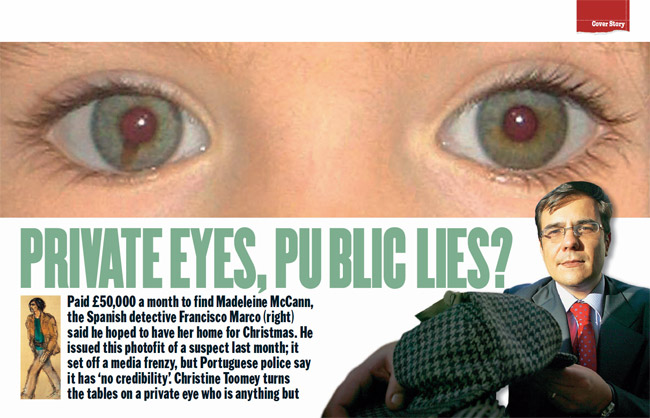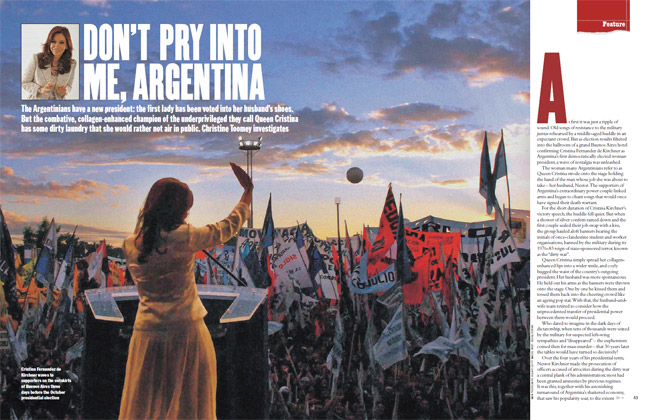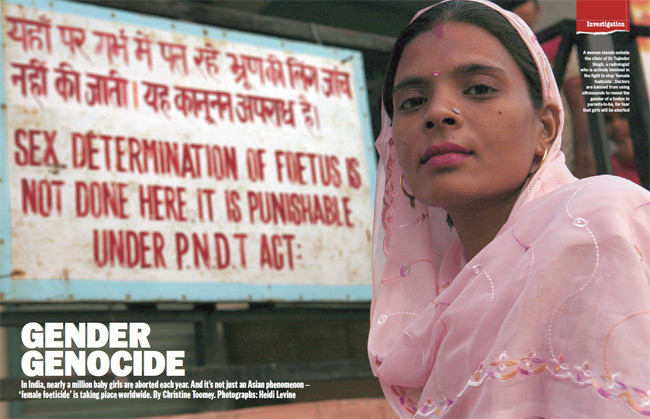 March 28, 2008
March 28, 2008
Investigation
While revolutionising Cuba, Fidel Castro had another, more personal, agenda: he was an insatiable womaniser who callously abandoned his lovers and left behind a string of illegitimate children
There are no photographs of her parents in the bungalow in Miami’s Little Havana where Alina Fernandez Revuelta lives. But she need only glance at the triangular birthmark on her left arm to be reminded of the illicit union that led to her conception. The skin blemish runs in the family of Fidel Castro.
When Alina was a few months old, Castro dispatched one of his sisters to check if the infant bore the mark. Only then did he accept she was his. Ten years later, Alina’s mother, Natalia “Naty” Revuelta, told her the man who sometimes visited their house at night, enveloping the girl in clouds of cigar smoke and, once, giving her a bearded doll dressed in olive-green uniform to look like himself, was her father. When she was 12, Castro conceded Alina could carry his name. After a childhood of neglect, of being ignored when she wrote begging him to visit, she refused. By then Castro was firmly entrenched as Cuba’s Maximo Jefe — maximum leader — a position he would hold for nearly half a century, until anointing his brother Raul president earlier this year.
The chaos Castro’s communist regime has wrought on one of the most beautiful islands in the Caribbean has seen more than 2m of his countrymen flee into exile. But it is his personal path of destruction through the lives of those closest to him, the legions of women he has slept with and the children they have borne him, that has, until now, been a closely guarded secret.
Castro’s private life has always been strictly taboo in Cuba’s state-controlled media. He has rarely been photographed with any of the women he has been involved with, and whenever such pictures have appeared, the women have been captured coincidentally, in the background.
“He was good at PR,” says Alina, a diminutive 52-year-old with doleful brown eyes. “He always portrayed himself as this lonely man with a beard and cigar, fighting imperialism 24 hours a day with nothing else on his mind.” Nothing could be further from the truth. As his countrymen brace themselves for the mandatory flag-waving that will accompany the 50th anniversary of the revolution next month, Alina and others who fled to the “city of worms”, as the Cuban strongman calls Miami, are stripping away Castro’s mask. The picture they paint is of a serial philanderer with an unknown number of progeny.
“My mother always said he was very passionate,” says Alina. Castro wooed her mother, a green-eyed high-society belle, with feverish letters written from prison, when he was incarcerated between November 1953 and May 1955 after his first attempt to overthrow Cuba’s despised dictator Fulgencio Batista. They begin, “My dearest Naty”, “My incomparable Naty”. “You’re audacious and I like that. I am on fire. Write to me, for I cannot be without your letters. I love you very much.”
“When you’re in jail you have all the time in the world to become a poet, a manipulator, a psychologist,” Alina says. She has reason to be bitter. She and her mother suffered at Castro’s hands. So did the woman he was married to when he was declaring his love for Naty. Mirta Diaz-Balart had already borne Castro a son, Fidelito, or Little Fidel, four years old when his father was jailed. Castro met Mirta through her brother, a fellow law student at Havana University, and pursued her despite opposition from her family, which had connections to the Batista regime and thought him beneath her. Castro was the third of seven children born out of wedlock to a domestic servant, Lina Ruz Gonzalez, and her master, Angel Castro, a peasant who became a wealthy sugar-plantation owner. During his early years, Fidel and his siblings lived with their mother in a shack adjoining the house where Angel lived with his wife and their two children.
At the age of five, Castro and two siblings were sent to live with impoverished Haitian foster parents. He was then sent to a Jesuit boarding school in Havana, where, though a brilliant student, he was bullied for being illegitimate and not baptised. “His psychological make-up comes from being a bastard, a second-class citizen in his own home, who grew up determined he’d never be made to feel that way again,” says Andy Gomez, assistant provost at Miami University’s Institute for Cuban and Cuban-American Studies. “Since he had little sense of identity as he was growing up, he created his own” — one that would always be in control, never again dependent on anyone, least of all a woman.
“I’ve a feeling that deep down he may be shy and emotionally vulnerable,” Alina concedes.
Castro was well into his teens before his father dissolved his first marriage and married Lina. From then on, it seems his parents indulged him materially, paying for a lavish honeymoon when he married Mirta in 1948. But he soon tired of his bride, who had little interest in politics. Sure that armed struggle could overthrow Batista, he was fast becoming a charismatic champion of social justice and national sovereignty, and his attempts to foment revolt were attracting followers, including Naty Revuelta. Also married, but bored, she sold her jewels for the rebels to buy weapons and sent Castro the key to her home (in an envelope laced with perfume) so that he could hold clandestine meetings there. Their relationship was still platonic when Castro was jailed. But he was infatuated with the woman once described as having the looks of a movie star “dipped by the gods into a golden oil, like Ava Gardner and Rita Hayworth”.
By this time Mirta’s family connections with the Batista regime had driven a wedge between her and Castro, and in one letter to Naty he joked cruelly that at least prison gave him some peace from domestic arguments: “I’m going to write to the [prison] tribunal reproaching them for having sentenced me to 15 years rather than 200.” Two letters Castro wrote to his wife and would-be lover were switched. When Mirta read what had been meant for Naty she was devastated, filed for divorce and quickly married again, moving with Fidelito to New York. Castro vowed revenge, writing to one of his sisters from prison that he could not bear to think of his son sleeping under the same roof as “my most repulsive enemies”.
A messy custody battle over Fidelito followed the divorce. Mirta once resorted to kidnapping her son when Castro refused to return him after a visit, and was then forced to return to live in Cuba if she wanted to remain with her child. She eventually went into exile in Spain and has never spoken of her marriage to Castro, some believe because if she did she’d never be allowed back to Cuba to visit her Fidelito, now a 59-year-old nuclear scientist with children of his own.
Care of his son was not uppermost in Castro’s mind, however, when he got out of prison. He swiftly indulged his passion for Naty, and Alina was conceived. He then left for a period of exile in Mexico, to continue plotting revolution with his new comrade-in-arms, Che Guevara, before returning to Cuba and spending two years waging guerrilla warfare from the mountains of the Sierra Maestra. When his rebel band overthrew Batista in January 1959, Castro paraded the streets of Havana astride a Sherman tank with Fidelito and another loyal comrade-in-arms, Huber Matos, by his side. From then, the revolutionary hero had women at his feet. “He was young, charismatic and powerful. He didn’t have to do much to attract them,” says Alina. During the Sierra Maestra years, he had acquired a new mistress. Celia Sanchez, not known for her looks, was a committed revolutionary and a born organiser. She would jealously guard Castro from other women for the next 2½ decades.
Huber Matos perches on the edge of his seat in the Miami home where he has lived in exile for nearly 30 years, his eyes blazing as he spits out the words “crook”, “unscrupulous” and “zero morals” to describe the man he once fought alongside for Cuba’s freedom. Matos is remarkably fit for a man of 90 who spent 20 years in prison — 16 in solitary confinement — for accusing Castro of betraying the democratic ideals of the Cuban revolution.
Matos and Celia Sanchez were close friends. “She was a good person, very Catholic, very passionate about social justice,” he says. “When I got there it was very clear she was sleeping with Castro. She was both his secretary and his lover. He told me she was ‘very useful’. I thought he should have treated her with more respect, but women were just instruments to Castro. I do not believe he is a man with any personal sentiment or feelings. He uses people, and once they have served their purpose he gets rid of them.”
Celia’s gatekeeping failed to prevent numerous sexual liaisons, as Castro’s prowess increased with his power. One of the few to have kissed and told on the Cuban leader is Marita Lorenz, then a naive 19-year-old German-American concentration camp survivor, whom Castro seduced in February 1959. Lorenz claims he installed her as his lover for seven months in a suite in the Havana Libre hotel, formerly the Havana Hilton, which he took over as his private residence in the months after deposing Batista. “Every day, letters came from women all over the world offering to do anything to meet him,” Lorenz, who witnessed a string of flings, has said. She was spurned, she says, after she became pregnant and had an abortion.
She returned to the US and was enlisted by the CIA to assassinate her former lover. They gave her two capsules of botulism to drop in his drink. But, waiting for him in the Havana Libre, she panicked and flushed them down the bidet. In a scene straight out of a thriller, Lorenz describes how Castro came in, lay down on the bed with a cigar and asked her: “Did you come here to kill me?” When she admitted she had, he pulled out a handgun and, with his eyes closed, passed it to her. She describes how Castro chewed his cigar, smiled and said, “You can’t kill me. Nobody can”, before sleeping with her and allowing her to flee.
The CIA failed in more than 630 attempts to assassinate the Cuban leader, while his reputation as a lady-killer flourished. There was his reputed affair with the Italian actress Gina Lollobrigida, and alleged couplings with an unnamed Cuban actress who claimed he was a selfish brute for simply “putting his pants down, and quick”. One underage dancer at the Tropicana nightclub said he smoked throughout; another said he never took his boots off.
Celia didn’t put a stop to such dalliances, seeing them as little threat. But one relationship she was determined to thwart was that with Alina’s mother, barring her rival’s access to Castro at every turn. When Alina was eight, she was dispatched to Paris with her mother, who had been given a spurious mission to carry out chemical espionage, on the orders, Alina believes, of the woman she calls “La Venenosa” — the poisonous one. When they returned to Cuba, Naty was kept on the sidelines and shunted from one minor ministerial job to another.
Alina was a nervous and rebellious teenager, developing eating disorders for which her father ordered she undergo psychiatric treatment. She married four times in quick succession — her father attending only the first nuptials — and started mixing with dissidents. When Castro refused to let her leave the island, Alina sought the help of exiles and, in 1993, at the age of 37, was eventually smuggled out on a false passport.
Naty remained in Havana and has never spoken critically of Castro. “She receives no privileges now or special attention. She has gone through very hard times. I think her heart was broken by my father,” says Alina. It is the only time in our conversation she has called him that.
Drive west through Havana’s suburbs and eventually you approach what used to be a fishing village, Jaimanitas. After the revolution, the area became heavily militarised. There is a military academy here, but also a far more secret installation — bristling with soldiers and secret police — that those Cubans who know of its existence call Punto Cero, or ground zero. At the heart of the complex is a swimming pool, basketball and tennis courts, a helicopter landing pad and the entrance to a tunnel to Havana’s military airport. It is said that Castro could survive at this secret compound for two years without ever having to leave.
For years it was rumoured that, in addition to Celia, who kept an apartment in Havana, Castro had another long-term mistress living at ground zero: Dalia Soto del Valle had been a champion swimmer in her youth and had caught Castro’s eye in the early 1960s, when she worked as a teacher on his literacy campaign. Dalia, known as Lala, bore Castro five sons, all with names beginning with “A” in homage, it is said, to Alexander the Great, Castro’s hero: Angel, Alex, Antonio, Alejandro and Alexis. There were even reports that Castro and Dalia had married in 1980 (the year Celia died), though Castro seemed to dispel such rumours in an interview with Oliver Stone in 2003 when he said being married once was “more than enough”.
Images of Dalia seated several rows behind Castro at public events have surfaced over the years. Then six years ago an ex-girlfriend of their son Antonio smuggled out of Cuba a secretly filmed video of Castro with Dalia, their grown sons and several grandchildren. The Cuban leader was pictured eating breakfast in his pyjamas and chatting with his grandchildren as they played in the pool. In 2006 a young woman named Idalmis Menendez fled into exile and began talking in detail about Castro’s secret home life. Idalmis had been married to Castro and Dalia’s second son, Alex. She portrayed Dalia as a scheming spy who secretly taps her sons’ phones and passes reports of their conversations to their father; she said Castro would pore over these reports at night while watching videos of dissident activity filmed by Cuba’s secret police on a giant TV screen — one of his few luxury items — in his private quarters. While Castro, now 82, lives relatively frugally — his brother Raul, 77, being the one to indulge in the material trappings of power — Idalmis says Dalia dresses simply only in Castro’s company. As soon as he leaves, Idalmis says her former mother-in-law changes into designer clothes and smothers herself with Chanel perfume.
Very little is known about Castro and Dalia’s sons. “For some reason he secluded her from the rest of the family. It seems she [Dalia] is now more known abroad than in Cuba. Yet she is the one who has lasted. Maybe she is more patient,” Alina muses about a woman she has never met.
Alina did meet her older half-brother Fidelito, by chance, in a lift when she was 12 and he was 18 and both were going to visit their Uncle Raul. From him she learnt about the existence of another half-brother, roughly Fidelito’s age, called Jorge Angel, conceived on a train in the autumn of 1948. The three siblings eventually formed a friendship of sorts.
Within days of coming to live in Miami in 2001, after a period spent in Spain and elsewhere in the US, Alina was informed by her aunt (Castro’s sister Juanita, who fled into exile more than 40 years ago) that she also had a half-sister, Francisca Pupo, who had been living in exile in Miami for five years. She knows little more about her than that. Many of those who know about Castro’s youthful indiscretions have taken their secrets to the grave.
Lazaro Asencio, 83, also fled into exile in Miami after falling out with Castro. He recalls the Cuban leader asking to borrow his blue Buick car for the night in 1952. “He said he wanted to take a pretty local girl out,” says Asencio. Years later he was approached in the street by a woman holding the hand of a seven-year-old girl. The child, she told him, had been conceived in the back of his car that night. Castro later dispatched his brother to buy her a house and organise birthday parties for their daughter. Asencio doesn’t know if Castro ever came to visit the girl himself. The daughter was Francisca Pupo.
When I ask Alina how many siblings she thinks she has, she pauses. “There are eight,” she says, hesitating slightly before adding, “I think.”
The number could be far higher. Almost as an aside, Andy Gomez of Miami University told me the story of a German businessman he met who, in 2002, had just returned from a business trip to Cuba. At one formal dinner, in a gesture of largesse, Castro had turned to him and said, “I am going to give you a gift,” before leaning back to his doctor, always in close attendance, and instructing him to “get my German friend here a box of those pills I take on a daily basis”.
Gomez took the pills to be analysed, hoping to shed light on Castro’s secret health issues (a year before, Castro had fainted in public). “When the lab called me back, they said, ‘You’re not going to believe this,’ ” says Gomez, containing his laughter. “Those pills were the highest strength Viagra available on the market.”






